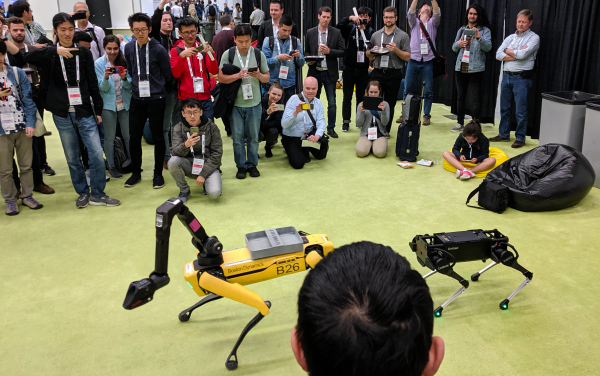This is a followup to my Making Computers Useful series, started all the way back in 2014. (Funnily enough, the 2013-era iMac featured in that series is now pretty damn useless as it has fallen out of update range, and locks up if you run Dropbox and Google Drive at the same time).
But, the overall goal here is to document some of the stuff that I need to do to make computers work for me. Typically, there’s a lot of friction in software, and it takes a good bit of work to make that all function on a new machine. Sometimes that becomes a deep dive.
This is one of those stories.
So today, while updating the Embodied AI Workshop’s website prior to the launch of the 2023 version, I wanted to run the tree command. Tree is great because it can help you understand the structure of a directory tree, like so:
I felt I needed this because the Embodied AI website is built on yarn and gatsby, and it turned a relatively simple site into 1.6 gigabytes of generated junk (which I noticed when one of my older computers started literally wheezing as it tried to mirror all those unexpected files):
As it turns out, you can get tree via Homebrew. Homebrew is a “package manager,” kind of like an “app store for the command line,” and Homebrew helps you get standard Linux tools, like tree, onto your Mac so you can take advantage of all the hidden Unix goodness in your Macintosh.
However … I’m a bit leery of Homebrew because this is how it installs itself:
I mean, WHAT? curl a file and run it with bash? Seriously. Now, look, I’m not saying Homebrew isn’t safe - every indication is that it is - but that this METHOD of installation is a recipe for disaster.
Why? Well, in case you’re not in the know, what this installation instruction is suggesting is to DOWNLOAD RANDOM CODE FROM SOMEWHERE ON THE INTERNET and RUN IT ON YOUR COMPUTER WITHOUT CHECKING IT AT ALL!
Nothing can go wrong with this plan.
Now, I’m no expert, but I’m familiar enough with this stuff to know what I’m doing. SO, first I checked with a few quick searches to see [is homebrew for mac safe] and it appeared to be.
SO I downloaded the software with JUST the CURL part, like so:
curl -fsSL https://raw.githubusercontent.com/Homebrew/install/HEAD/install.sh > homebrew-install.sh... so I could examine it more closely.
Folks, seriously, never do this on a site you do not trust.
After I had the code, I then inspected this homebrew-install.sh file to find out whether it was safe. I didn't see any obvious malware, but when I ran it, it wanted me to TYPE MY PASSWORD.
Seriously?
Please, I’m asking you, do not hot-pipe random software straight off the internet and run it straight from the command line and give it your password when it asks. If someone intercepts the website, and gets your password, they can do anything.
(SERIOUSLY. Once I was working with a legitimate Google representative about a Google ads program and when I went to log in to Google ads to check something, a hacker injected a fake Google ads site between me and Google, and damn near got my password. Only two-factor authentication saved me, as it broke some key link in the chain.)
BUT … it is the PATTERN I’m talking about here, not the specifics. Everything I’ve seen about Homebrew says that it is safe. I’ve even used it before, on other machines. SO, after some more research, and a little more code analysis, I confirmed this password-asking was safe, and gingerly went ahead.
And it went fine.
I had to pay thirty million bitcoin to a Russian spammer, but I wasn’t using it anyway, and I’m sure at least they got to buy a cup of coffee or something with it. :-D
Seriously. It went fine. And I love Homebrew. I just go through this every time I need to “bash” run a piece of “curl”-ed software straight off the Internet and then it asks for my password.
Still, tree worked like a charm. (Screenshots of its use were above). There are more pieces of Homebrew software I need to install, but as one test, I tried to install “banner”, a program to create oversized pieces of text, which I use in scripts to alert me that a big task is done.
But, it seems like Mac already has a version of banner, which works differently on Mac than Linux, printing VERY large ASCII banners that are vertical rather than horizontal. That’s useful, but not for my case, so I dug around for an equivalent tool. brew install figlet is the way to go:
All great!
It didn’t help me with my work on the Embodied AI website, as I had already moved on to fixing other problems on that website, and was only “brewing” things in the background while I did other tasks (like remote-attend the church vestry retreat).
But removing this friction will help me in the future. The next time I need to examine the tree structure of a directory, it's one command away. I can put banners in my scripts. And I can easily add new software with 'brew' the next time it comes up.
AND, as a bonus, I discovered a site which is doing something very much like what I want to do with the Making Computers Useful series, Sourabh Bajaj’s Mac OS Setup Guide, which “... covers the basics of setting up a development environment on a new Mac.” I have an internal document called “Mac OS X New System Tasks” which documents for myself the travails I go through every time I get a new Mac, and Sourabh’s guide seems like it provides a public version of what I want to do. Which is great! Less work for me. ;-D
On to the next task!
-the Centaur
P.S. As another added bonus, I composed this in Google Docs, and pasted it straight into Gutenberg, the new Wordpress block editor. It worked like a charm ... EVEN DOWN TO PASTING IN THE IMAGES! If this is a feature of Gutenberg, I will have to consider saying my favorite three words about it ... "I was wrong."
P.P.S. Don't hold your breath on that, though, I'm waiting for the other shoe to drop.




















 Alan Turing, rendered over my own roughs using several layers of tracing paper. I started with the below rough, in which I tried to pay careful attention to the layout of the face - note the use of the 'third eye' for spacing and curved contour lines - and the relationship of the body, the shoulders and so on.
Alan Turing, rendered over my own roughs using several layers of tracing paper. I started with the below rough, in which I tried to pay careful attention to the layout of the face - note the use of the 'third eye' for spacing and curved contour lines - and the relationship of the body, the shoulders and so on.
 I then corrected that into the following drawing, trying to correct the position and angles of the eyes and mouth - since I knew from previous drawings that I tended to straighten things that were angled, I looked for those flaws and attempted to correct them. (Still screwed up the hair and some proportions).
I then corrected that into the following drawing, trying to correct the position and angles of the eyes and mouth - since I knew from previous drawings that I tended to straighten things that were angled, I looked for those flaws and attempted to correct them. (Still screwed up the hair and some proportions).
 This was close enough for me to get started on the rendering. In the end, I like how it came out, even though I flattened the curves of the hair and slightly squeezed the face and pointed the eyes slightly wrong, as you can see if you compare it to the following image from
This was close enough for me to get started on the rendering. In the end, I like how it came out, even though I flattened the curves of the hair and slightly squeezed the face and pointed the eyes slightly wrong, as you can see if you compare it to the following image from  -the Centaur
-the Centaur 






